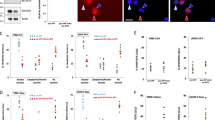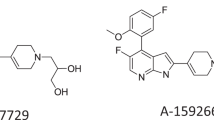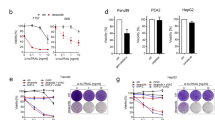Abstract
Survivin is a member of the inhibitor of apoptosis protein (IAP) family and functions both as an apoptosis inhibitor and a regulator of cell division. Survivin overexpression is common in many human tumors and correlates with survival in large cell non-Hodgkin's lymphoma. To evaluate this molecule as a potential therapeutic target in large-cell lymphoma, we evaluated the effect of survivin inhibition both in vitro and in vivo. Using an antisense oligonucleotide (ASO) approach, cell growth was significantly inhibited in the DoHH2, RL and HT lymphoma cell lines. In a lymphoma xenograft model, the development of tumors as well as the growth of established tumors was inhibited in the survivin ASO-treated mice compared to controls. To assess the efficacy of the survivin ASO in combination with other biological agents, we combined the survivin ASO with an anti-CD20 monoclonal antibody, rituximab. The effect of survivin ASO and rituximab in combination was additive in vitro. In vivo, however, suppression of tumor growth with the combination was not significantly superior to controls. We conclude that inhibition of survivin expression is an attractive therapeutic strategy in aggressive non-Hodgkin's lymphomas, and that combining survivin ASO with rituximab may enhance the efficacy of this approach.
This is a preview of subscription content, access via your institution
Access options
Subscribe to this journal
Receive 12 print issues and online access
$259.00 per year
only $21.58 per issue
Buy this article
- Purchase on Springer Link
- Instant access to full article PDF
Prices may be subject to local taxes which are calculated during checkout





Similar content being viewed by others
References
Leoncini L, Del Vecchio MT, Megha T, Barbini P, Galieni P, Pileri S et al. Correlations between apoptotic and proliferative indices in malignant non-Hodgkin's lymphomas. Am J Pathol 1993; 142: 755–763.
Witzig TE, Habermann TM, Kurtin PJ, Schroeder G, Stenson MJ, Greipp PR . S-phase fraction by the labeling index as a predictive factor for progression and survival in low grade non-Hodgkin's lymphoma. Cancer 1995; 76: 1059–1064.
Ansell SM, Kurtin PJ, Stenson M, Habermann TM, Greipp PR, Therneau TM et al. Evaluation of the proliferative index as a prognostic factor in diffuse large cell lymphoma: correlation with the International Index. Leukemia Lymphoma 1999; 34: 529–537.
Ambrosini G, Adida C, Altieri DC . A novel anti-apoptosis gene, survivin, expressed in cancer and lymphoma. Nat Med 1997; 3: 917–921.
Reed JC, Bischoff JR . BIRinging chromosomes through cell division and survivin' the experience. Cell 2000; 102: 545–548.
Altieri DC . The molecular basis and potential role of survivin in cancer diagnosis and therapy. Trends Mol Med 2001; 7: 542–547.
Fortugno P, Wall NR, Giodini A, O'Connor DS, Plescia J, Padgett KM et al. Survivin exists in immunochemically distinct subcellular pools and is involved in spindle microtubule function. J Cell Sci 2002; 115: 575–585.
Li F, Ackermann EJ, Bennett CF, Rothermel AL, Plescia J, Tognin S et al. Pleiotropic cell-division defects and apoptosis induced by interference with survivin function. Nat Cell Biol 1999; 1: 461–466.
Uren AG, Wong L, Pakusch M, Fowler KJ, Burrows FJ, Vaux DL et al. Survivin and the inner centromere protein INCENP show similar cell-cycle localization and gene knockout phenotype. Curr Biol 2000; 10: 1319–1328.
Adida C, Berrebi D, Peuchmaur M, Reyes-Mugica M, Altieri DC . Anti-apoptosis gene, survivin, and prognosis of neuroblastoma. Lancet 1998; 351: 882–883.
Adida C, Haioun C, Gaulard P, Lepage E, Morel P, Briere J et al. Prognostic significance of survivin expression in diffuse large B-cell lymphomas. Blood 2000; 96: 1921–1925.
Ambrosini G, Adida C, Sirugo G, Altieri DC . Induction of apoptosis and inhibition of cell proliferation by survivin gene targeting. J Biol Chem 1998; 273: 11177–11182.
Asanuma K, Moriai R, Yajima T, Yagihashi A, Yamada M, Kobayashi D et al. Survivin as a radioresistance factor in pancreatic cancer. Jpn J Cancer Res 2000; 91: 1204–1209.
Grossman D, Kim PJ, Schechner JS, Altieri DC . Inhibition of melanoma tumor growth in vivo by survivin targeting. Proc Natl Acad Sci USA 2001; 98: 635–640.
Islam A, Kageyama H, Takada N, Kawamoto T, Takayasu H, Isogai E et al. High expression of Survivin, mapped to 17q25, is significantly associated with poor prognostic factors and promotes cell survival in human neuroblastoma. Oncogene 2000; 19: 617–623.
Kawasaki H, Altieri DC, Lu CD, Toyoda M, Tenjo T, Tanigawa N . Inhibition of apoptosis by survivin predicts shorter survival rates in colorectal cancer. Cancer Res 1998; 58: 5071–5074.
Lu CD, Altieri DC, Tanigawa N . Expression of a novel antiapoptosis gene, survivin, correlated with tumor cell apoptosis and p53 accumulation in gastric carcinomas. Cancer Res 1998; 58: 1808–1812.
Monzo M, Rosell R, Felip E, Astudillo J, Sanchez JJ, Maestre J et al. A novel anti-apoptosis gene: Re-expression of survivin messenger RNA as a prognosis marker in non-small-cell lung cancers. J Clin Oncol 1999; 17: 2100–2104.
Olie RA, Simoes-Wust AP, Baumann B, Leech SH, Fabbro D, Stahel RA et al. A novel antisense oligonucleotide targeting survivin expression induces apoptosis and sensitizes lung cancer cells to chemotherapy. Cancer Res 2000; 60: 2805–2809.
Smith SD, Wheeler MA, Plescia J, Colberg JW, Weiss RM, Altieri DC . Urine detection of survivin and diagnosis of bladder cancer. JAMA 2001; 285: 324–328.
Tanaka K, Iwamoto S, Gon G, Nohara T, Iwamoto M, Tanigawa N . Expression of survivin and its relationship to loss of apoptosis in breast carcinomas. Clin Cancer Res 2000; 6: 127–134.
Sarela AI, Macadam RC, Farmery SM, Markham AF, Guillou PJ . Expression of the antiapoptosis gene, survivin, predicts death from recurrent colorectal carcinoma. Gut 2000; 46: 645–650.
Sarela AI, Scott N, Ramsdale J, Markham AF, Guillou PJ . Immunohistochemical detection of the anti-apoptosis protein, survivin, predicts survival after curative resection of stage II colorectal carcinomas. Ann Surg Oncol 2001; 8: 305–310.
Chiodino C, Cesinaro AM, Ottani D, Fantini F, Giannetti A, Trentini GP et al. Communication: expression of the novel inhibitor of apoptosis survivin in normal and neoplastic skin. J Invest Dermatol 1999; 113: 415–418.
Adida C, Recher C, Raffoux E, Daniel MT, Taksin AL, Rousselot P et al. Expression and prognostic significance of survivin in de novo acute myeloid leukaemia. Br J Haematol 2000; 111: 196–203.
Kato J, Kuwabara Y, Mitani M, Shinoda N, Sato A, Toyama T et al. Expression of survivin in esophageal cancer: correlation with the prognosis and response to chemotherapy. Int J Cancer 2001; 95: 92–95.
Olie RA, Simoes-Wust AP, Baumann B, Leech SH, Fabbro D, Stahel RA et al. A novel antisense oligonucleotide targeting survivin expression induces apoptosis and sensitizes lung cancer cells to chemotherapy. Cancer Res 2000; 60: 2805–2809.
Kanwar JR, Shen WP, Kanwar RK, Berg RW, Krissansen GW . Effects of survivin antagonists on growth of established tumors and B7-1 immunogene therapy. J Natl Cancer Inst 2001; 93: 1541–1552.
Bono F, Schaeffer P, Herault JP, Michaux C, Nestor AL, Guillemot JC et al. Factor Xa activates endothelial cells by a receptor cascade between EPR-1 and PAR-2. Arterioscler Thromb Vasc Biol 2000; 20: E107–E112.
Zaman GJ, Conway EM . The elusive factor Xa receptor: failure to detect transcripts that correspond to the published sequence of EPR-1. Blood 2000; 96: 145–148.
Valentine MA, Meier KE, Rossie S, Clark EA . Phosphorylation of the CD20 phosphoprotein in resting B lymphocytes. J Biol Chem 1989; 264: 11282–11287.
Einfeld DA, Brown JP, Valentine MA, Clark EA, Ledbetter JA . Molecular cloning of the human B cell CD20 receptor predicts a hydrophobic protein with multiple transmembrane domains. EMBO J 1988; 7: 711–717.
Reff ME, Carner K, Chambers KS, Chinn PC, Leonard JE, Raab R et al. Depletion of B cells in vivo by a chimeric mouse human monoclonal antibody to CD20. Blood 1994; 83: 435–445.
Shan D, Ledbetter JA, Press OW . Signaling events involved in anti-CD20-induced apoptosis of malignant human B cells. Cancer Immunol Immunother 2000; 48: 673–683.
Hofmeister JK, Cooney D, Coggeshall KM . Clustered CD20 induced apoptosis: Src-family kinase, the proximal regulator of tyrosine phosphorylation calcium influx and caspase 3-dependent apoptosis. Blood Cells Mol Dis 2000; 26: 133–143.
Golay J, Zaffaroni L, Vaccari T, Lazzari M, Borleri GM, Bernasconi S et al. Biologic response of B lymphoma cells to anti-CD20 monoclonal antibody rituximab in vitro: CD55 and CD59 regulate complement-mediated cell lysis. Blood 2000; 95: 3900–3908.
Harjunpaa A, Junnikkala S, Meri S . Rituximab (anti-CD20) therapy of B cell lymphomas: direct complement killing is superior to cellular effector mechanisms. Scand J Immunol 2000; 51: 634–641.
Coiffier B, Haioun C, Ketterer N, Engert A, Tilly H, Ma D et al. Rituximab (anti-CD20 monoclonal antibody) for the treatment of patients with relapsing or refractory aggressive lymphoma: a multicenter phase II study. Blood 1998; 92: 1927–1932.
McLaughlin P, Grillo-López A, Link BK, Levy R, Czuczman MS, Williams ME et al. Rituximab chimeric anti-CD20 monoclonal antibody therapy for relapsed indolent lymphoma: half of patients respond to a four-dose treatment program. J Clin Oncol 1998; 16: 2825–2833.
Davis TA, White CA, Grillo-López A, Velasquez WS, Link B, Maloney DG et al. Single-agent monoclonal antibody efficacy in bulky non-Hodgkin's lymphoma: results of a phase II trial of rituximab. J Clin Oncol 1999; 17: 1851–1857.
Acknowledgements
This work was supported in part by Grants CA92104 and CA97274 from the National Institutes of Health.
Author information
Authors and Affiliations
Corresponding author
Rights and permissions
About this article
Cite this article
Ansell, S., Arendt, B., Grote, D. et al. Inhibition of survivin expression suppresses the growth of aggressive non-Hodgkin's lymphoma. Leukemia 18, 616–623 (2004). https://doi.org/10.1038/sj.leu.2403281
Received:
Accepted:
Published:
Issue Date:
DOI: https://doi.org/10.1038/sj.leu.2403281
Keywords
This article is cited by
-
Phase-I trial of survivin inhibition with EZN-3042 in dogs with spontaneous lymphoma
BMC Veterinary Research (2020)
-
Molecular Bio-Imaging Probe for Non-Invasive Differentiation Between Human Leiomyoma Versus Leiomyosarcoma
Reproductive Sciences (2020)
-
Survivin, a molecular target for therapeutic interventions in squamous cell carcinoma
Cellular & Molecular Biology Letters (2017)
-
Survivin selective inhibitor YM155 induce apoptosis in SK-NEP-1 Wilms tumor cells
BMC Cancer (2012)
-
Survivin expression in patients with newly diagnosed nodal diffuse large B cell lymphoma (DLBCL)
Medical Oncology (2012)



